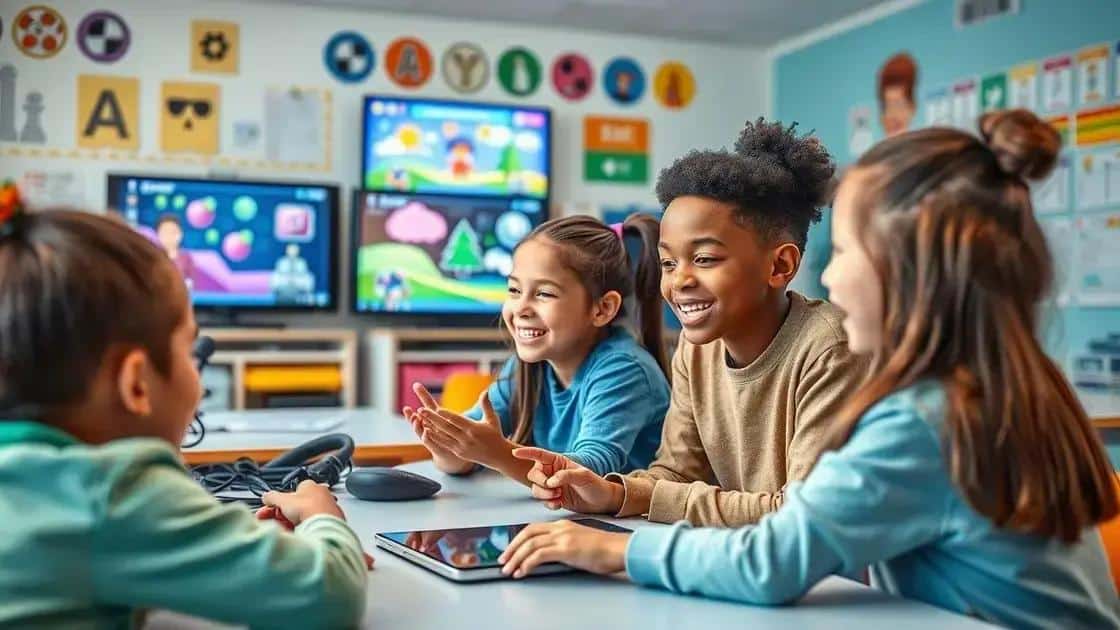Education revolution: how AI and joy will transform learning
Anúncios
The integration of AI in education enhances student engagement and joy by personalizing learning experiences, fostering creativity, and creating a supportive atmosphere while addressing challenges such as technology access and teacher training.
Education revolution: how AI and joy will transform learning is reshaping our classrooms. Have you ever thought about how technology and positive emotions could create a better learning environment? Let’s dive into this exciting transformation.
Understanding the role of AI in education
Understanding the role of AI in education opens doors to exciting possibilities. It’s changing how we teach and learn, and those changes can lead to better outcomes for students.
AI technologies assist teachers in personalizing learning experiences. By analyzing student data, AI can help in creating tailored lesson plans that address individual needs. Imagine a classroom where each student progresses at their own pace!
How AI Benefits Education
The benefits of AI in education are numerous. Here are some key points:
-
🎓 Personalized learning experiences for each student
-
🧑🏫 Automated administrative tasks for teachers, allowing them to focus on instruction
-
📊 Data-driven insights to identify student strengths and weaknesses
-
💻 Interactive learning tools that engage students in new ways
Additionally, AI tools, like intelligent tutoring systems, provide support outside traditional classroom hours. Students can ask questions and receive answers, making learning more flexible and accessible.
AI can also enhance teacher training. By analyzing classroom interactions, schools can offer targeted professional development and effective strategies to improve teaching methods.
Challenges of Implementing AI
Despite its advantages, there are challenges in the integration of AI in education. Some concerns include:
- Equity in access to technology across different schools.
- Data privacy issues regarding student information.
- The need for ongoing teacher training to effectively use AI tools.
As we embrace the future, understanding the role of AI in education will help us overcome these challenges and create a more effective learning environment.
The impact of emotions on learning

The impact of emotions on learning is profound. When students feel happy or excited, they are more likely to engage with the material. Positive emotions can boost motivation and enhance memory retention, which is essential for effective learning.
Conversely, negative emotions can create barriers to understanding. Stress or anxiety can hinder a student’s ability to focus and absorb new information. Therefore, it is crucial to foster a positive emotional climate in the classroom.
How Emotions Influence Learning
Research shows that emotions directly affect cognitive processes. Here are some ways emotions influence learning:
- Positive emotions lead to increased creativity and problem-solving skills.
- Emotional support from teachers helps build trust and enhances learning.
- Strong emotional experiences can lead to better memory recall.
- Students who feel safe are more likely to take risks in their learning.
Building an emotionally supportive learning environment can encourage students to express themselves freely. When students share their thoughts and feelings, it creates a stronger classroom community. This sense of belonging promotes collaboration and enhances overall learning outcomes.
Teachers can use various strategies to bolster student emotions. Incorporating fun activities, using humor, and providing positive feedback can create a joyful atmosphere. Additionally, implementing mindfulness practices can help students manage stress and enhance focus, leading to better learning experiences.
Emotional Regulation Techniques
To support students in managing their emotions, educators can introduce emotional regulation techniques. These might include:
- Breathing exercises to calm anxiety.
- Journaling to process feelings.
- Group discussions to share experiences and support each other.
Recognizing that emotions play a critical role in learning is essential for both educators and students. By prioritizing emotional well-being, we can create an environment where students thrive academically and socially.
How joy enhances student engagement
How joy enhances student engagement is a fascinating topic in education. When students are happy and excited, they tend to participate more actively in class. Joyful experiences lead to a deeper connection with the material.
Research suggests that joy can improve attention and increase retention of information. Students who find joy in learning are more likely to engage with their peers, ask questions, and explore topics further. This means that creating a joyful environment is crucial for maximizing student potential.
The Role of Joy in Learning
Joy plays a pivotal role in how students engage with learning. Here are some key aspects:
- Active Participation: Students who feel joy are more likely to engage in discussions and collaborative activities.
- Improved Memory: Positive emotions can enhance memory, making it easier to recall information later.
- Curiosity Boost: Joy sparks curiosity, encouraging students to ask questions and seek knowledge beyond the classroom.
- Resilience: Happy students are often more resilient, able to cope with challenges and setbacks in their learning journey.
Incorporating games and fun activities into lessons can significantly enhance joy in the classroom. When students are having fun, they are more likely to be engaged and willing to learn. Activities such as group projects with a creative twist or interactive lessons can create memorable experiences.
Furthermore, the emotional connection between teachers and students also plays a critical role in fostering joy. When teachers create a supportive and fun atmosphere, it helps students feel safe and ready to learn. Positive teacher-student interactions can lead to increased motivation and enthusiasm among students.
Strategies to Enhance Joy in Learning
To enhance joy and promote engagement, educators can implement several strategies:
-
🎉 Create a classroom culture that celebrates successes, big or small
-
😂 Use humor and creativity when presenting lessons
-
🖌️ Incorporate hands-on activities and projects that allow for self-expression
-
🗣️ Encourage student feedback and input in the learning process
By focusing on joy, educators can transform the learning experience into something more engaging and enjoyable. This shift has the potential to create lifelong learners who are passionate about their education.
AI tools that bring joy to classrooms

AI tools that bring joy to classrooms are transforming the way students learn and interact with educational content. These technologies not only enhance learning experiences but also make them more fun and engaging for students.
From interactive games to personalized learning assistants, the use of AI in education can spark enthusiasm among students. When students are excited about what they are learning, they tend to perform better.
Types of AI Tools Enhancing Classroom Joy
Several types of AI tools enrich learning environments. Here are some common categories:
- Adaptive Learning Platforms: These tools customize lessons based on individual student needs, helping them learn at their own pace.
- Gamification Applications: Incorporating game elements into lessons, these tools motivate students to complete tasks and achieve goals.
- Chatbots and Virtual Tutors: These AI-driven assistants provide students with support outside of classroom hours, answering questions and offering explanations.
- Creative Learning Tools: AI tools that allow students to create art, music, or stories encourage self-expression and creativity.
Using these AI tools can lead to joyful learning experiences. For instance, gamified lessons create a playful environment where students can collaborate and compete in a friendly manner. This not only makes learning fun but also fosters social skills.
Teachers play a vital role in integrating AI tools effectively. By combining traditional teaching methods with technology, educators can create a balanced approach that resonates with students. Training educators to utilize these tools can enhance the overall effectiveness of the learning experience.
Benefits of AI Tools in Education
The benefits of utilizing AI tools in classrooms are vast:
-
📚 Increased engagement through interactive learning
-
🎯 Ability to tailor education to individual learning styles
-
🤝 Enhanced collaboration among students
-
🌍 Support for diverse learning needs
With the right AI tools, classrooms can transform into lively spaces full of excitement and joy. As students become more engaged in their learning, they develop a love for knowledge that lasts a lifetime.
Real-life examples of AI in joyful learning
Real-life examples of AI in joyful learning showcase how technology can create engaging educational experiences. Many schools around the world have started to implement AI tools that encourage creativity and fun while learning.
One notable example is the use of adaptive learning platforms. These platforms tailor educational content to meet individual student needs, making lessons more enjoyable. When students receive materials that match their learning pace, they are more likely to stay focused and enthusiastic about their studies.
Interactive Learning Games
Many educators have adopted gamified learning experiences leveraging AI. These games often include challenges that help students develop critical thinking skills while having fun.
- Prodigy Math: This engaging math game adapts to each student’s level, turning math into an exciting quest.
- Kahoot: This platform allows teachers to create fun quizzes that students can answer in real-time, bringing competitive joy to learning.
- Duolingo: An innovative language learning app that uses game-like elements to encourage users to practice consistently.
These examples show that integrating gamification in the classroom can lead to higher student engagement and motivation.
Another exciting implementation of AI is through virtual reality experiences. Schools are beginning to use virtual reality to create immersive lessons that transport students to different environments. Imagine learning about ancient civilizations by virtually exploring their ruins! Such experiences not only captivate students but also make complex topics more relatable.
Case Studies from Schools
A school in California has implemented AI-driven personalized learning plans. Teachers use data from AI analytics to understand each student’s strengths and weaknesses. As a result, students are more engaged because they can work on subjects they find challenging while progressing at their own pace.
In addition, a school in Finland successfully incorporated social-emotional learning with the help of AI tools. Students interact with virtual companions that provide emotional guidance and encourage healthy social interactions. This approach helps students develop essential life skills while enjoying their educational experience.
These real-life examples highlight how AI is not only redefining the way students learn but also making education a joyful adventure.
Challenges in integrating AI and joy in education

Challenges in integrating AI and joy in education are important to understand. While many schools are excited about using AI technologies, there are several hurdles they must overcome to create a joyful learning environment.
One of the biggest challenges is ensuring that all students have access to the necessary technology. In some areas, schools lack the resources to provide devices or reliable internet connections. When students are unable to utilize AI tools, it can lead to disparities in learning experiences.
Technology Adoption and Training
An additional challenge is the need for proper training. Teachers may feel overwhelmed by new AI tools, especially if they haven’t received adequate professional development. When educators are unsure how to effectively use AI, it can lower their confidence and excitement about adopting these technologies.
- Providing ongoing training programs for teachers can help.
- Encouraging collaboration among staff can foster a supportive environment.
- Sharing success stories can motivate teachers to try new approaches.
Another concern is the potential for AI tools to reinforce negative emotional experiences. If students struggle with the technology or feel pressured to perform, it can create anxiety rather than joy. Therefore, it’s crucial to design AI tools that promote a positive and supportive learning atmosphere.
Balancing Curriculum with Technology
Finding the right balance between traditional teaching methods and the introduction of AI tools is also a challenge. Teachers must carefully integrate technology without losing the essential human connection in the classroom. Creating interactive and joyful lessons requires a blend of technology and personal interaction.
Moreover, educators need to consider how AI impacts students’ mental health. The overuse of technology can lead to burnout or disengagement. Teachers must incorporate breaks and activities that enable students to connect with each other and enjoy their learning experiences.
Overall, addressing these challenges requires collaboration between educators, administrators, and technology providers. By keeping the focus on creating joyful learning environments, schools can better integrate AI into their educational practices.
FAQ – Questions about AI and Joy in Education
What are the benefits of using AI in classrooms?
AI enhances engagement, personalizes learning, and fosters creativity, making lessons more enjoyable for students.
How can teachers effectively integrate AI tools?
Teachers can integrate AI tools by receiving proper training, collaborating with peers, and gradually incorporating technology into their lessons.
What challenges do schools face when adopting AI?
Schools may face challenges such as access to technology, teacher training, and balancing traditional teaching methods with new tools.
How does joy influence student learning?
Joy in learning increases student engagement, motivation, and retention, leading to a more positive educational experience.






